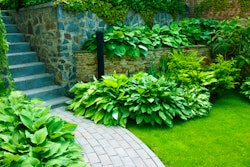 Photo: Pixabay
Photo: PixabayTrees are vital to our environment. They provide oxygen, improve air quality, help preserve soil, and even support wildlife. On top of all that, trees in the residential landscape also provide beauty, shade, and even sentimental value.
According to the United States Department of Agriculture Natural Resources Conservation Service, there are 950 tree species in 81 plant families that are native to North America (not including species varieties or subspecies). With so many choices, how do you choose what's best for your clients?
Below is a list of some of the most commonplace native trees in the United States, according to several Federal surveys of tree species stem count.
Red maple (Acer rubrum)
Always offering a bit of red no matter the season, with red buds in the winter, red flowers in the spring, red leafstalks in the summer and red foliage in the fall, red maples can tolerate a variety of soils, helping it have a wide range. It can grow in a USDA Hardiness Zones 3-9.
This shade tree can grow to 40-60 feet high and 40 feet wide when mature. It has a fast growth rate and prefers full sun. It is the state tree of Rhode Island.
Loblolly pine (Pinus taeda)
Also known as bull pine or old-field pine, this is one of the fastest growing southern pines and is native to the east coast of North America ranging from New Jersey to Florida to Texas. It provides food and shelter for a number of southeastern birds and the seeds are consumed by chipmunks and squirrels.
This pine has a USDA Hardiness Zones of 6-9 and can grow in a variety of soils. It grows 60-90 feet high and 25-35 feet wide at maturity. It is the state tree of Arkansas.
American sweetgum (Liquidambar styraciflua)
Native to the southeastern United States, this tree has glossy green star-shaped leaves that turn yellow, purple and red in the fall and stay on the tree late into the season. It produces round burr-like fruit that collects underfoot in the landscape and can quickly take over abandoned areas.
Sweetgum grows in USDA Hardiness Zones 5-9 and has a height of 60-75 feet and 40-50 feet spread when mature. It can grow in various soils but does not tolerate pollution well.
Douglas-fir (Pseudotsuga menziesii)
An evergreen with a cone-shape when young that becomes more pyramidal as it ages, the Douglas-fir’s needle coloration depends on the variety. According to the Arbor Day Foundation, Douglas-fir is written as one word or hyphenated to indicate that it is not a true fir. It is the state tree of Oregon. It is also a popular Christmas tree choice due to its nice shape and the needles do not fall off easily.
It has a USDA Hardiness Zones of 4-6. It can grow to 40-70 feet high and 12-20 feet wide at maturity. It prefers acidic or neutral soils and does not do well in dry, poor soils.
Quaking aspen (Populus tremuloides)
Said to have the widest natural range of any tree in North America, quaking aspen gets its name from how the slightest breeze causes the leaves to “quake.” Aspen is known as the largest living organism, as it reproduces by sending sprouts from their roots, meaning all the trees in a clone are connected. It is the state tree of Utah.
This shade tree thrives in USDA Hardiness Zones 1-7 and grows to a height of 40-50 feet. It spreads 20-30 feet when mature. It is a fast grower and it prefers abundant moisture.
Sugar maple (Acer saccharum)
A showstopper in the fall, sugar maple leaves’ turn yellow, burnt orange and red in autumn. This tree does best in well-drained, fertile soil and should not be planted in confined areas or where salt is a problem. It is a staple of the Northeast maple syrup industry.
Sugar maples can grow in USDA Hardiness Zones 3-8. They can grow to a height of 60-75 feet and spread to 40-50 feet when mature. It has a slow to medium growth rate. It is the state tree of New York, Vermont, West Virginia and Wisconsin.
Balsam fir (Abies balsamea)
This evergreen has a narrow, spire shape with shiny dark green needles. It is adapted to a number of sites from swamps to rocky mountainsides, but it grows best in cold climates with acidic, moist soil. This is another popular Christmas tree option.
It grows in the USDA Hardiness Zones 3-5. It grows from 45-75 feet high and 20-25 feet wide at maturity. It has a slow growth rate.
Flowering dogwood (Cornus florida)
A popular understory tree with biscuit-shaped flowers, flowering dogwood also offers glossy red berries that attract birds. It blooms in April and May and does well in acidic, well-drained soil.
Flowering dogwood thrives in USDA Hardiness Zones 5-9. It reaches a maximum height of 25 feet and spread of 25 feet at maturity. It is the state tree of Missouri and Virginia, while it is the state flower of North Carolina.
Lodgepole pine (Pinus contorta)
Getting its name from its slender pole-like trunk, the lodgepole pine does best in full sun to light shade and adapts to a variety of soils. It begins to bear cones early on from six to 10 years of age.
This evergreen grows in USDA Hardiness Zones 4-8. It has a mature height of 70-80 feet and a spread of 20 feet. It has a slow to medium growth rate.
White oak (Quercus alba)
Considered to be the king of kings when it comes to trees, according to naturalist Donald Peattie, white oak is the state tree of Connecticut, Illinois and Maryland. This shade tree’s acorns provide food for many types of wildlife.
The white oak grows in Hardiness Zones 3-9 and prefers slightly acidic to neutral well-draining soils. It has a mature height of 50-80 feet and a spread of 50-80.
As you celebrate the role of trees in the environment and maybe even plant some new trees for customers, keep some of these native trees in mind, as they can tolerate the local climate better and are more beneficial to the wildlife in the area as well.
You can also use the Arbor Day Foundation’s Tree Wizard to find best tree recommendations for your customers.











